Sunday is one of the most active days in Anigua, because the tourists. In the Central Park, close to the fountain that represents sirens, I meet Michael Sherer, a travel writer that lives in the city, to talk about this place he calls " the unofficial paradise of Guatemala ".
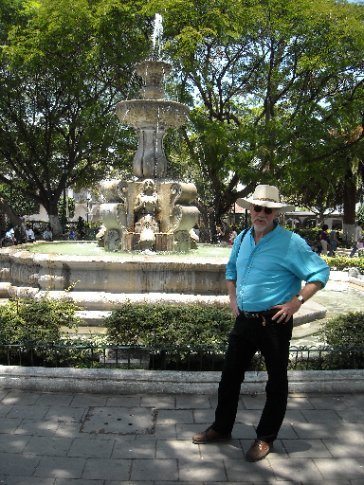
The social reality of the country is complex, in terms of delinquency and political conflicts. Last days have been marked by the death of the attorney Rodrigo Rosenberg and for today it has been called a national unemployment, but Antigua always is at the margin of these political problems. Suddenly, Michael shows to me that in the town hall a group of people has assembled. They are not more than ten, have a linen and shout. Sherer makes me notice the strange of the situation. Nevertheless in some minutes everything returns to normality.
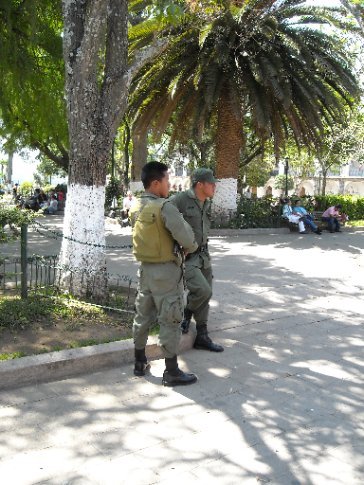
In Antigua safety abounds, there are three types of policemen, the traffic police, the tourism policeman who accompany the visitors on places that might be dangerous and the police entrusted to attack the crime. Those who have more work are traffic police, because the rules are not taken very seriously and there is a wide diversity of vehicles. Besides the majority of cars have polarized glasses, for safety Michael explains to me; there are the tuk-tuk, small vehicles motorized of thin wheels that vibrate constantly; in the sidewalks it is normal to see many parked motorcycles, specially the weekends, Sherer says to me that the owners have the habit of bring them from the capital to show them, and finally there are the horses, they are less, but still it is possible to see some wagons or people as Fred Haywood on his horse.

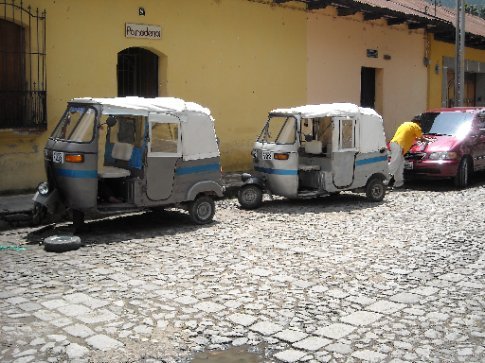
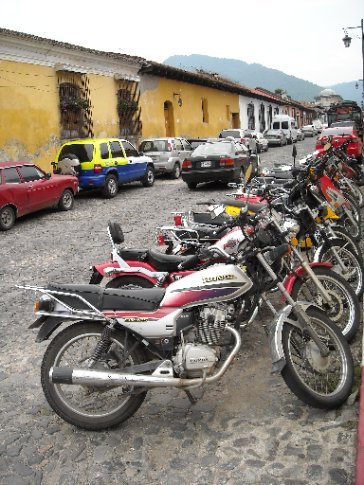
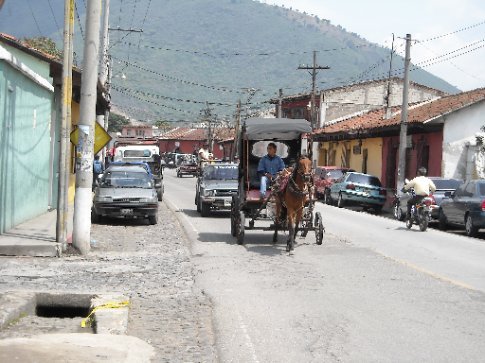
Haywood is a hoary and wrinkled Englishman, with a long moustache, jeans and rodomh boots , detained on a brown horse in a side of the park. Michael greets him and tells me that he is the owner of Ravenscroft Riding Stables, there gives riding lessons and does walks along the city. A magnetic city for foreigners.
I ask Michael, who is native to San Francisco, why he chose Antigua to retire when he stopped working on the market of real estate and centered himself in writing. He answers me that he is charmed with the local culture, the beautiful women, the possibility of eating in a different restaurant every night, and clearly, that the weather is perfect. I say to him it has been difficul for me getting used to it. He smiles. After that Michael recommended me a couple of restaurants, we say goodbye and I continue walking the city.
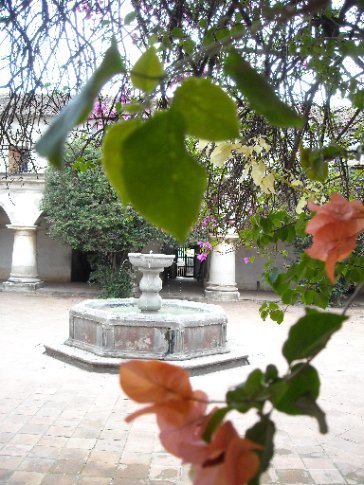
I find another ruins and without thinking it, I get in. A low man with a moustache and a credential, approaches to me . He offers to be my guide. I answer him that I’m not interested. He insists me lowering his initial price. I say no again. He insists. Finally I accept, paying exactly the half of the original price. We are in the ex-convent of the Capuchinas Sisters and as the guide will not get tired to repeat mechanically again and again, it is said that the sisters entered to the convent and never came out alive or dead. Though actually the more nearby I was of seeing one of the sisters during my visit, were a few manikins lamentable in its pretension of verisimilitude.
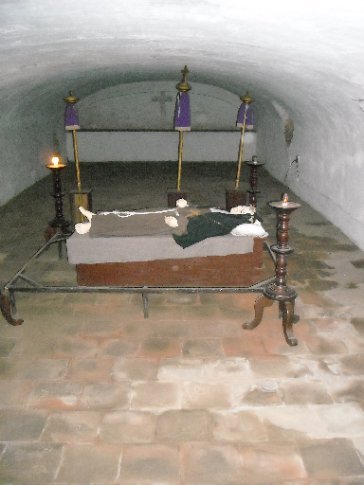
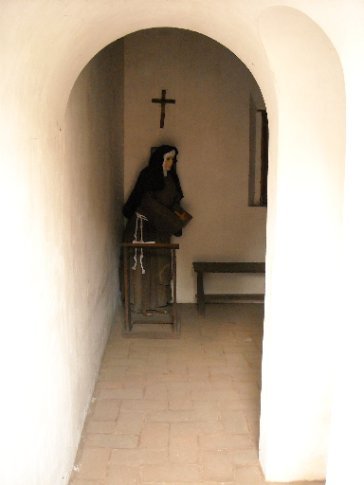
Lamentable also seem to be the life of these sisters. They could not be seen by anyone, therefore in mass they had a theater box covered by an enormous wood and to receive communion it was across a grid in which the priest introduced his hand with the ostia.
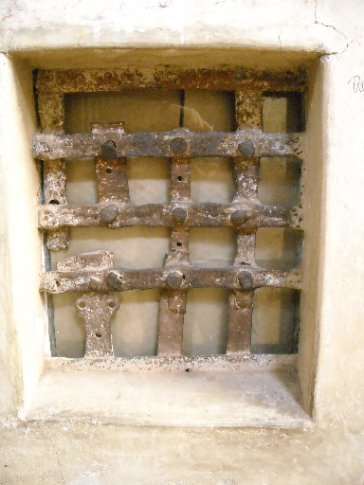
The isolation was so extreme that when the city was evacuated by the earthquake of 1773, they were the last ones to go away in the darkness of the night, according to the guide. They passed long hours of spiritual retirement and reflection in 17 individual cells and if they were sinning, were punished in a few narrow spaces of stone with a small hole in the roof in order that they receive a constant drop of water on her heads when it was raining.
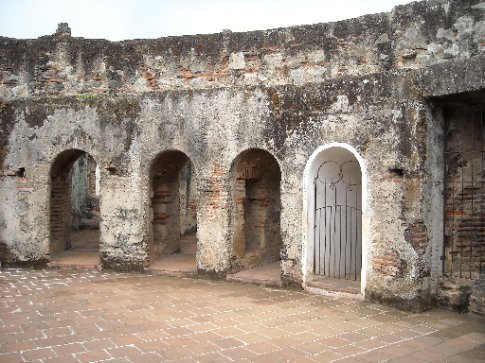
The guide makes me sit down in the cell, also in the bath of the religious and to not be less in a room of privileged acoustics he sings a ranchera. Finally he calls me his “friend” and when we say goodbye, he does not stop giving me life advices. Assurance he was lonely and bored, assurance he was not even alive. At least he took a good picture of me next to the fountain of the sisters.
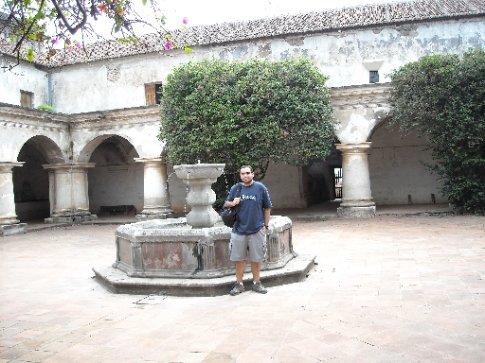
From the Capuchinas to The Cathedral. The ruins of the last one are the least glamorous, since they are combined by slightly elegant doses of contemporary life as basins for the water, bricks and scaffoldings that give indications of a remodeling. The nicest thing are a few flowers between the stones, as a couple I see at the distance. Both represent life in the ruins. Construction in the destruction.
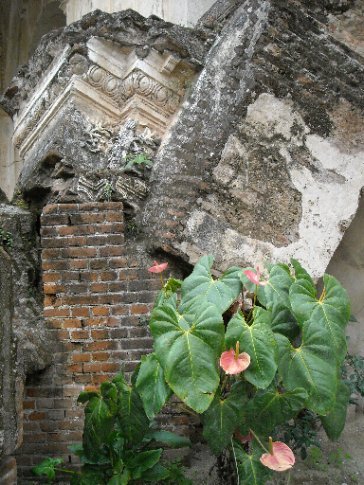
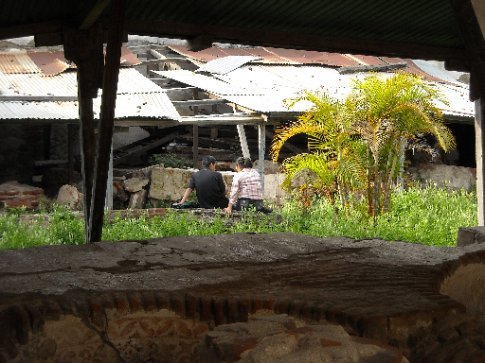
I go to the underground and I do not understand a thing, everything is dark and the floor is of dirt and the grandmother of a family that comes besides my does not stop expressing her dread, but the only thing that scares are the regards and declarations of love in the walls close to the sign that requests not to write on them.
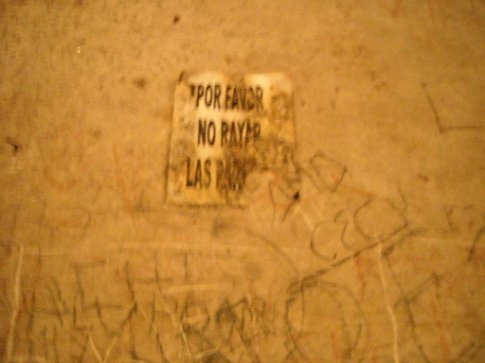
Continuing with the unexpected religious route. I come to the sanctuary of the first guatemalan saint. The Brother Pedro of San Jose Betancurt, that as it is indicated was canonized on July 30, 2002 by the Pope Juan Paul II.
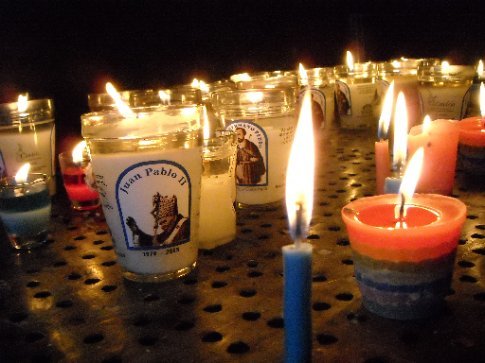
In the exterior there is a garden full of colors, which contrasts with the sobriety inside the temple, where the yellow lights give a hot atmosphere to the tomb of the saint where the people pray knelt down around it silently, while in the central part of the temple a baptism is celebrated.
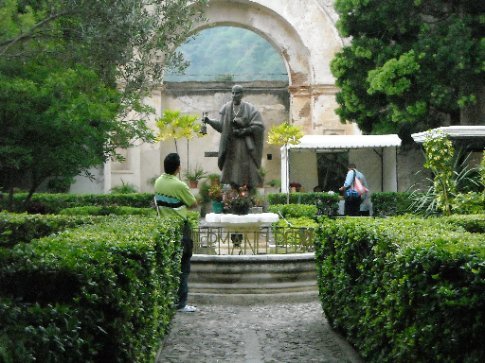
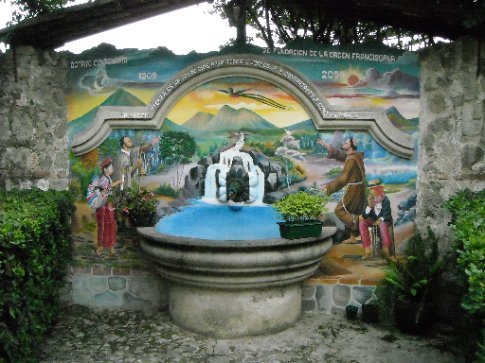
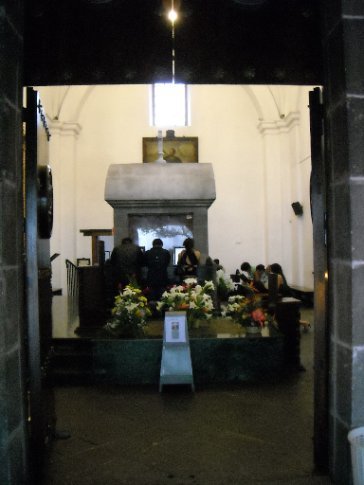
I go out of the sanctuary, its getting late, I pass next to the Tanque de la Unión, a community washing place from 1853 reconstructed in 1979.
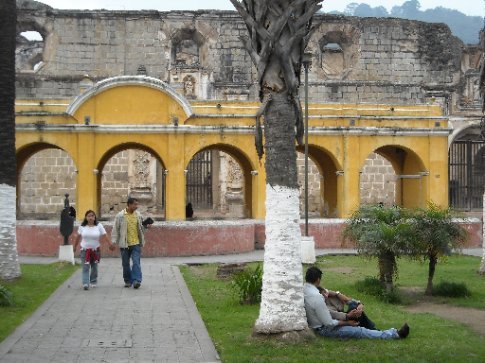
Still it is used for it, though at the hour I go I do not see more than young couples holding hands and hugging, in the tank or in the park next to it. I think that for them it is also getting late, when someone is in love the time always is short. Am I falling in love with this city?
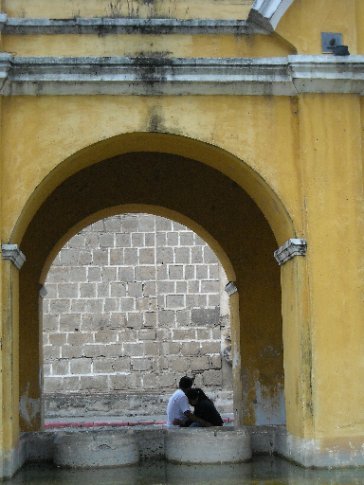
Spanish:
La ruta espiritual
El domingo es uno de los días más activos en Anigua, porque se concentra el turismo. En el Parque Central, junto a la fuente que representa unas sirenas, me encuentro con Michael Sherer, escritor de viajes que vive en la ciudad, para conversar sobre este lugar que él llama “el paraíso no oficial de Guatemala”. La realidad social del país es compleja, en términos de delincuencia y conflictos políticos. Los últimos días han estado marcados por la muerte del abogado Rodrigo Rosenberg y para hoy se ha convocado a un paro nacional, pero Antigua logra siempre mantenerse al margen de esos problemas políticos. De pronto, Michael me muestra que frente al ayuntamiento hay reunido un grupo de personas. No son más de diez, llevan un lienzo y gritan. Sherer me hace notar lo poco común de la situación. Sin embargo en algunos minutos todo vuelve a la normalidad. En Antigua la seguridad abunda, hay tres tipos de policías, están los encargados del tránsito, los policías de turismo que acompañan a los visitantes a lugares que podrían ser peligrosos y la policía encargada de combatir el crimen. Los que tienen más trabajo son los de tránsito, porque las reglas no son tomadas muy en cuenta y hay una amplia diversidad de vehículos. Además de lo automóviles que tienen en su mayoría los vidrios polarizados, por seguridad me explica Michael; están los tuk-tuk, pequeños vehículos motorizados de ruedas delgadas que vibran constantemente; en las veredas es normal ver muchísimas motocicletas estacionadas, especialmente los fines de semana, Sherer me dice que los dueños suelen venir de la capital para lucirlas y por último están los caballos, son menos, pero aún es posible ver algunas carretas o a personajes como Fred Haywood sobre su caballo. Haywood es un inglés canoso y arrugado, con largo bigote, jeans y botas para montar, detenido sobre un corcel café en un costado de la plaza. Michael lo saluda y me cuenta que es el dueño Ravenscroft Riding Stables, allí enseña a montar y hace paseos por la ciudad. Una ciudad magnética para los extranjeros. Le pregunto a Michael, que es oriundo de San Francisco, por qué eligió Antigua para retirarse, cuando dejó de trabajar en el mercado de bienes raíces y se concentró en la escritura. Me contesta que le encanta la cultura del lugar, las bellas mujeres, la posibilidad de comer en un restaurante diferente cada noche, y claro, que el clima es perfecto. Le digo que es algo a lo que me ha costado acostumbrarme. Sólo sonríe. Luego de que Michael me recomiende un par de restaurantes, nos despedimos y sigo recorriendo la ciudad. Me encuentro con otra fachada en ruinas y sin pensarlo, entro. Se me acerca un hombre bajo de bigote con una credencial. Me ofrece ser mi guía. Le digo que no. Me insiste bajando un poco su precio inicial. Vuelvo a decirle que no, pero no da su brazo a torcer. Finalmente logro que me cobre la mitad exacta de su cifra original. Estamos en el ex convento de las Hermanas Capuchinas y como el guía no se cansará de repetir mecánicamente una y otra vez, se dice que las hermanas entraron al convento y nunca más salieron ni vivas ni muertas, aunque en realidad lo más cercano que estuve de ver a alguna de las hermanas durante mi visita, fueron unos maniquíes bastante lamentables en su pretensión de verosimilitud. Lamentable también pareció ser la vida de estas religiosas. No podían ser vistas por nadie, por lo tanto en misa tenían un palco cubierto por un abanico enorme de madera y para comulgar lo hacían a través de una rejilla en la que el sacerdote introducía su mano con la ostia. El aislamiento era tan extremo que cuando se evacuó la ciudad por el terremoto de 1773, ellas fueron las últimas en irse en la oscuridad de la noche, según el guía. Pasaban largas horas de retiro espiritual y reflexión en 17 celdas individuales y si pecaban eran castigadas en unos espacios estrechos de piedra con un pequeño agujero en el techo para que recibieran constantemente una gota de agua sobre su cabeza cuando llovía. El guía me hace sentarme en la celda, también en el baño de las religiosas y para no ser menos en una sala de acústica privilegiada se pone a cantar una ranchera. Al final ya me trata de amigo y cuando nos despedimos no deja de darme consejos para la vida. Seguro estaba sólo y aburrido, seguro ni siquiera estaba vivo. Al menos me tomó una buena foto junto a la fuente de las hermanas. De las Capuchinas a La Catedral. Las ruinas de esta última son las menos glamorosas, ya que están combinadas con dosis poco elegantes de vida contemporánea como cubetas para el agua, ladrillos y andamios que dan indicios de una remodelación. Lo más bonito son unas flores entre las piedras, como una pareja que se ve a la distancia, ambos representan vida entre las ruinas. Construcción en la destrucción. Bajo al subterráneo y no entiendo nada, todo está oscuro y el suelo es de tierra y la abuela de una familia que viene tras de mi no deja de expresar su temor, pero lo único que asusta son los saludos y declaraciones de amor en las paredes junto al cartel que solicita no rayarlas. Siguiendo con la improvisada ruta religiosa. Llego al santuario del primer santo guatemalteco. El Hermano Pedro de San José Betancurt, que como indica una placa fue canonizado el 30 de julio del año 2002 por el Papa Juan Pablo II. En el exterior hay un patio plagado de colores, que contrasta con la sobriedad dentro del templo, donde las luces amarillas dan una atmosfera cálida a la tumba del santo donde los fieles rezan arrodillados a su alrededor en silencio, mientras en la parte central del templo se celebra un bautizo. Salgo del santuario, se hace tarde, paso por el Tanque de la Unión, un lavadero comunitario de ropa de 1853 reconstruido en 1979. Aún es utilizado para eso, aunque a la hora a la que voy no veo más que a parejas jóvenes de la mano o abrazados, ya sea en el tanque o en el parque que está a su lado. Pienso que a ellos también se les hace tarde, cuando uno está enamorado el tiempo siempre es poco. ¿Me estaré enamorando de esta ciudad?